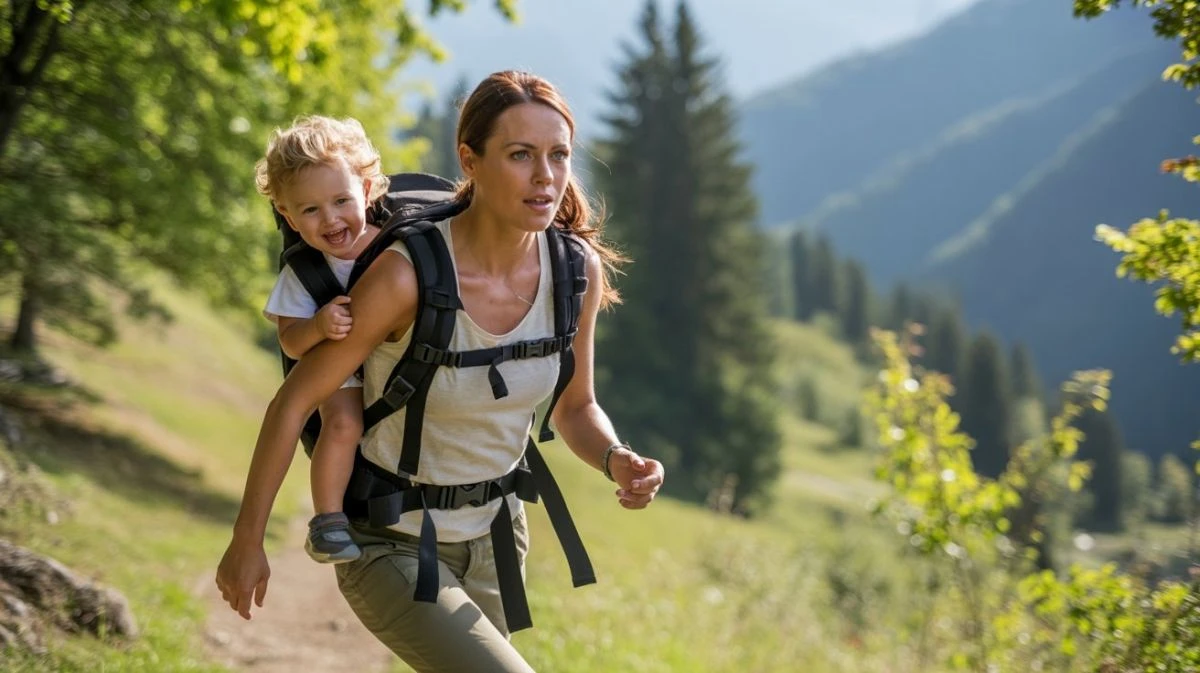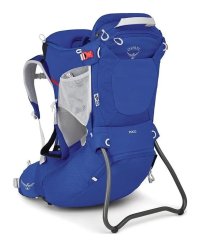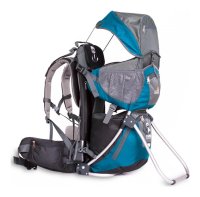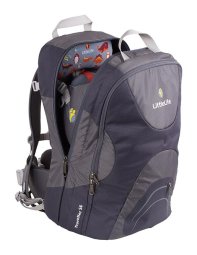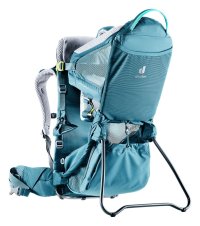Hiking with children is a great opportunity to spend time in nature and build family relationships. For parents with young children, it's important to ensure comfort and safety not only for the child but also for themselves. A child carrier backpack is the ideal solution if you want to tackle longer routes without limitations and ensure comfort for all participants on the trip.
Choosing the right carrier can be challenging, especially given the various options the market offers. In addition to comfort for the child and ergonomics for the parent, you also need to consider ease of use and practical accessories that can significantly simplify your trips. We'll help you choose the ideal carrier for your needs and ensure that every outdoor adventure is a pleasant experience for the whole family.
In this article, we primarily focus on outdoor child carriers – these are suitable for children who can already sit up independently.
Contents:
- How to Choose the Right Child Carrier?
- Types of Child Carriers and Their Uses
- Safety and Comfort for Child and Parent
- Accessories You'll Appreciate
- Practical Tips for Hiking with a Child
- How to Properly Maintain a Child Carrier
- FAQ – Frequently Asked Questions
- Conclusion: Recommendations for Choosing the Ideal Carrier
How to Choose the Right Child Carrier?
Ergonomics: What to Look For
An ergonomic carrier is key for both the child's healthy development and the comfort of the parent carrying them. Focus on models that have a properly shaped backrest, headrest, and wide, adjustable straps. An ergonomic carrier should provide the child with sufficient support to ensure the correct position of the spine and hips. A well-designed carrier distributes the child's weight evenly, thereby reducing the strain on your back and shoulders. You will especially appreciate quality weight distribution on longer hikes.
Carriers with good ergonomics ensure that the child is in a natural position where the hips are properly spread and the legs are in an "M" shape, which supports healthy development and reduces the risk of hip dysplasia. Ergonomics are also important for the carrier – wide and well-padded straps, hip belts, and the ability to adjust the carrier to the length of the carrier's back ensure that even longer periods of carrying will be comfortable.
Weight Capacity and Age Restrictions
When choosing, make sure the carrier is appropriate for your child's age and weight. Manufacturers usually state six months as the minimum age for using a carrier, while pediatricians recommend waiting until the ninth month. It is important that the child is able to sit up independently and hold their head up without support.
If your child is not yet able to sit on their own but you still want to get outdoors, you can take them on shorter trips in a sling or use an all-terrain stroller.
The decision itself is up to each parent. However, using a carrier prematurely can have a serious impact on the child's proper development. If you wait until the child can sit up, you certainly don't have to worry about negative health impacts.
The upper limit for using a carrier is determined by the manufacturer, who specifies the maximum possible weight capacity. Typically, it is possible to carry children up to 18-20 kilograms, which corresponds to the weight of a three-year-old child.
Tip: If your little adventurer has already outgrown the carrier, get them excited for future journeys with their own functional backpack!
Types of Child Carriers and Their Uses
Hiking Carriers
Ideal for longer hikes and outdoor activities. They feature a robust construction, higher weight capacity, and plenty of storage space. Hiking carriers often have an integrated frame that provides stability and support. These models are also often equipped with various safety features, such as five-point harnesses, which ensure the child stays securely in place even in more challenging conditions.
Hiking carriers are designed for longer periods of carrying and comfort for both the child and the parent. They have ergonomic padding and adjustable hip belts that distribute weight evenly and ensure comfort even on multi-hour hikes. These carriers are also equipped with storage compartments for food, drinks, clothing, and other equipment, making it easier to organize your gear.
Everyday Carriers
A lighter and more compact option, more suitable for shorter walks and urban environments. Everyday carriers are easy to fold and can often be worn on the front or back. These carriers are great for parents who want to have their hands free during daily errands while keeping their child close.
Everyday carriers are often very easy to adjust, allowing for quick adaptation to the current situation. These carriers are great for traveling by public transport, shopping, or visiting friends.
Safety and Comfort for Child and Parent
- Proper Seating of the Child: The child should sit stably with their legs in an "M" position. Check that the carrier has sufficient padding and adjustable rests. Proper seating ensures the child's hips are in the correct position and their head is in a safe position, with the ability to rest. Proper seating is crucial for the child's comfort and safety. Check that all straps are correctly adjusted and tight enough to keep the child in place, but not so tight as to cause discomfort.
- Another important element that can significantly contribute to the child's comfort are foot stirrups. Stirrups allow the child to rest their feet, help to better distribute weight, and prevent their legs from going numb during longer periods of carrying. The correct position of the feet in the stirrups supports healthy hip development and ensures the child's legs are not left dangling.
- Protection from the Elements: Some models include an integrated sunshade or even a rain cover. These features ensure the child's comfort in all weather. The sunshade protects the child from the sun, while the rain cover provides protection from rain and wind.
- In addition to protection from rain and sun, some carriers may also offer wind protection, which is particularly useful in autumn and winter.
Accessories You'll Appreciate
- Sunshade with UV Protection
A sunshade is a great accessory that protects the child from harmful sun rays. It is especially ideal for summer hikes when the sun is strongest. A sunshade is particularly important for young children who are more sensitive to direct sun. It ensures the child is not exposed to direct radiation, which can reduce the risk of sunstroke or sunburn.
- Rain Cover for Rainy Days
A rain cover ensures the child stays dry, even if you're caught in an unexpected downpour. The rain cover should be easily accessible and quick to deploy, so the weather doesn't catch you by surprise.
- Storage Pockets for Drinks, Diapers, and Other Essentials
Pockets are an important feature that allows you to have everything you need at hand. Carriers with plenty of storage pockets will make organization easier and ensure you're prepared for all situations. Storage pockets are great for storing everything you need to have on hand during a trip – from diapers and toys to a water bottle.
- Hip Belts for Better Weight Distribution
A hip belt helps to distribute the child's weight evenly and reduces the load on your back and shoulders. This allows you to carry the carrier for longer periods without discomfort or pain. A hip belt is an essential feature for all parents planning longer carrying sessions. Distributing the weight between the hips and shoulders means that even when carrying a heavier child, you won't feel as tired and can focus on the hike.
- Compatibility with Hydration Reservoirs
For parents planning longer trips, the compatibility of a child carrier with a hydration reservoir is a feature they will appreciate. A hydration reservoir allows for easy access to drinking water during the trip without having to stop and search for a bottle. Thanks to this solution, you and your little traveler will stay hydrated without unnecessary breaks.
Practical Tips for Hiking with a Child
Hiking with a child can be challenging, but with the right approach, you can avoid many complications. We recommend preparing for the trip with plenty of water, weather-appropriate clothing, and protective elements (e.g., a sunshade). Before the trip, it's a good idea to try the carrier at home or on a short walk to make sure everything fits as it should. When planning your route, consider the child's needs – frequent breaks for snacks or rest can significantly contribute to comfort and good mood. Also, bring small toys or other ways to keep the child entertained during the hike.
When hiking with a young child, good preparation and patience are the keys to success.
Tip: If you have an older sibling at home who is also a hiker, make their trips more enjoyable with their own hiking backpack!
How to Properly Maintain a Child Carrier
To keep your carrier in good condition for as long as possible, it's important to maintain it properly. Here are some tips on how to care for it:
- Clean the carrier regularly: After each trip, check if the carrier is dirty. Use a damp cloth to remove dirt and dust. If necessary, some parts can be machine washed, but always follow the manufacturer's instructions.
- Check for wear and tear: Regularly check the straps, buckles, and seams for wear or damage. In case of damage, contact the manufacturer or a repair specialist to ensure the child's safety.
- Storage: Store the carrier in a dry place away from direct sunlight. Proper storage will help keep the materials in good condition and prevent premature wear.
FAQ – Frequently Asked Questions
- From what age can I start using a child carrier?
It is usually recommended to start using a carrier from six to nine months, when the child can already sit up independently and hold their head. - How long can I carry a child in the carrier?
The carrying time depends on the comfort of the child and the parent. It is recommended to take regular breaks every 1–2 hours. - What is the maximum weight capacity of the carrier?
Most carriers have a maximum weight capacity of around 18–25 kg, which corresponds to the weight of a three-year-old child. - Is the carrier suitable for newborns?
Carriers are not suitable for newborns as they require the child to be able to sit up independently. For smaller babies, slings or newborn carriers are more appropriate. - What safety features should a carrier have?
A carrier should have a five-point safety harness, a stable frame, and sufficient padding for the child's comfort and safety. - Is it possible to use the carrier in the rain?
Yes, many carriers are equipped with a rain cover or a sunshade that protects the child from the rain. - Can I machine wash the carrier?
Some parts of the carrier can be machine washed, but always follow the manufacturer's instructions to avoid damaging the material. - Is it possible to use the carrier in winter?
Yes, but it is important to ensure that the child is dressed warmly enough and protected from wind and cold. - What is the difference between a hiking carrier and an everyday carrier?
Hiking carriers are more robust, have a higher weight capacity and more storage space, while everyday carriers are lighter and more compact. - Can a carrier damage the parent's back?
A properly adjusted carrier with a hip belt and ergonomic straps helps to distribute the weight and minimize the risk of back damage.
Conclusion: Recommendations for Choosing the Ideal Carrier
Choosing the right child carrier is crucial for the comfort and safety of both the child and the parent. When choosing, focus on ergonomics, weight capacity, safety features, and accessories that will make your trips easier. If you are planning longer hikes, choose a model with sufficient storage space and protection from the elements. Conversely, for shorter walks in the city, a lighter and more compact carrier will be ideal.
Don't forget to also consider your child's needs and your own preferences to make your joint trips as comfortable and enjoyable as possible. With a suitably chosen carrier, you can look forward to many unforgettable moments spent in nature.

